As more and more merchants flock to Google Shopping, you need to be prepared for a strong competition and identifying the most effective keywords is one of the crucial steps.
You might be wondering why. After all, every advertiser knows that bidding on keywords is not available in Google Shopping campaigns. In this campaign type, Google examines your feed website, and other elements, determining the keywords that are relevant to your products, and which search queries will activate your ads within the Shopping tab.
Still you need to know the best keywords in order to optimize critical components of your feed and to ensure that your desired keywords align with the display of your products. The ability to convert website traffic into customers is heavily reliant on conducting thorough keyword research specifically tailored for Google Shopping.
In this article, we will delve into 5 tactics that will empower you to find Google keywords that will perform best for your Google Shopping Ads, ultimately driving better results.
What are Shopping Ads in Google?
Google Shopping ads are a type of advertising format that allows businesses to showcase their products to potential customers.
The foundation of a Google Shopping ad campaign relies on two platforms: Google Ads and Google Merchant Center. These platforms provide advertisers with the tools needed to manage budgets, gain insights, and optimize ads effectively.
Google Shopping ads are created based on the product data provided by advertisers through the use of a Google product feed. This feed includes crucial details such as price, description, images, shipping and sales tax. Despite no bidding on keywords in Google Shopping like in Google Text ads campaigns (no buying keywords on Google Shopping), keyword research remains essential for creating an optimized product feed for this campaign type.
When users search for specific products or keywords related to those products, Google displays relevant Shopping ads that match their search intent. This enables advertisers to reach users who are actively looking to make a purchase.
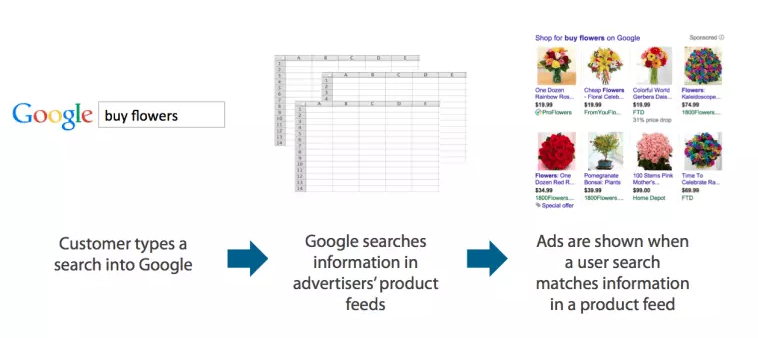
Google Shopping brand-based campaign | SearchEngineJournal
Where do Shopping Ads appear?
Google Shopping ads are mostly visible within the search results of Google when specific search queries are made. But they're not limited to appearing solely there.
They can be found on the dedicated Google Shopping tab, as well as on the websites of store owners, various shopping services, and apps. Furthermore, these ads also have the potential to appear on different Google networks and even YouTube.
Keyword targeting in Google Shopping
Keyword targeting is a crucial aspect of online advertising, helping businesses reach their target audience effectively. However, in the context of Google Shopping Ads, there is an important distinction to be made.
Contrary to traditional search advertising, keyword targeting as we know it does not exist within Google Shopping Ads. In Google Shopping, the relevance of your product listings and how they match users' search queries is determined by the product data in your Merchant Center feed. This means that Google's algorithms analyze your product data to determine which products are most relevant to display for specific search queries. The process of setting up your product feed bears striking similarities to search engine optimization (SEO).
While this process is intended to match users with relevant products, it can sometimes lead to random selections based on perceived relevance. This may result in displaying products that Google deems as "related" but might not be the most appropriate or conversion-friendly options for users.
To address this limitation, it is important to optimize your product data in the Merchant Center feed to accurately represent your products and increase relevancy. This includes providing detailed and accurate product titles, descriptions, attributes, and categorization. By optimizing your product data, you can enhance the chances of your products being displayed for relevant searches.
Google Shopping keywords research
Google Shopping ads have a different approach to keywords compared to traditional Google Ads. However, this doesn't mean that keyword research is unnecessary. In fact, it is highly important to ensure that all the relevant attributes in your feed such as titles, descriptions, image names, colors, sizes, materials and even more align with the user's search query in order to optimize your ad visibility, improve rankings and increase conversion rates.
Even before establishing the campaign structure, conducting keyword research is essential. By identifying best keywords for Google Ads Shopping that closely match the customer's search query through thorough market research, you can easily determine what customers are actively searching for. There are the most popular keywords on Google that you can find and use to boost your Google Shopping campaign.
How to search for keywords on Google for Google Shopping campaigns?
Google Ads keyword research tools like Keyword Planner may not directly support Google Shopping campaigns, but it can help. There are also alternative approaches and best practices you can follow.
You can utilize the Search Terms Report, which provides insights into the terms that triggered your ads. By analyzing this report, you can identify relevant search terms and consider them as potential keywords for your Google Shopping campaign.
You can also conduct keyword research for Product Pages. You can identify high-performing keywords related to your products using external tools or platforms like for example Ahref. Then you can incorporate these keywords strategically within your product titles, descriptions, and other relevant fields in your feed.
Keywords in product titles
For instance, when creating product titles, it is crucial to use the actual name of the product as customers may use specific search queries to find it. Through proper research, you can identify the most relevant keywords to include in the title along with other important details such as color, model number, size, etc.
You can easily compose your titles with optimized keywords using a feed management software, for example DataFeedWatch.
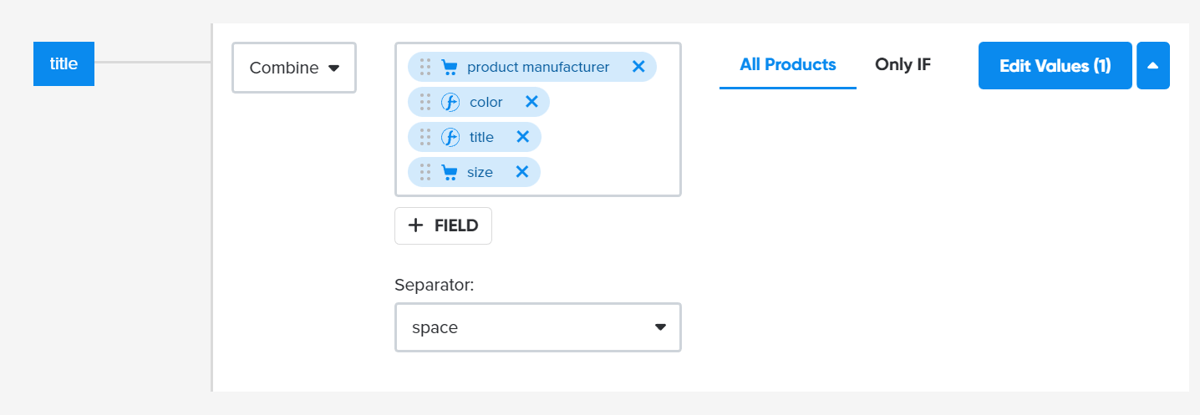
Optimizing product titles | DataFeedWatch
Keywords in descriptions
In product descriptions, incorporating one or two relevant Google Shopping keywords can enhance their effectiveness. Additionally, highlighting the most useful features and benefits as Google Shopping ads keywords in the description can attract potential customers. The same principle applies to the Google product type, where utilizing your researched Google Shopping keyword is recommended.
Negative keywords in Google Shopping
In addition to conducting keyword research and optimizing product data, another way to refine targeting in Google Shopping Ads is through negative keywords. They play a crucial role in optimizing Google Shopping campaigns.
Negative keywords allow you to specify the search terms for which you do not want your products to show up. By using negative keywords effectively, you can prevent your ads from being triggered by irrelevant search queries, thus saving your ad spend and improving the overall performance of their campaigns.
Eliminating high-volume but irrelevant keywords
When sorting keywords by irrelevancy, advertisers can identify high-volume but low-converting search queries. These are the keywords that are driving traffic to the campaign but not resulting in desired actions such as conversions or sales. By adding these keywords as negative keywords, advertisers can prevent their ads from appearing for these irrelevant queries and focusing their budget on more relevant terms.
Strategic decisions on budget allocation
In addition, negative keywords can also help advertisers reallocate their budget strategically. By excluding irrelevant but slightly related search queries, advertisers can ensure that their budget is directed towards more relevant and conversion-friendly terms. This can increase visibility on the carousel for the right audience, maximizing the chances of generating meaningful engagements and sales.
It's important to regularly review and optimize negative keywords based on campaign performance and user search behavior. This way, advertisers can always refine their targeting and ensure that their ads are shown to the most relevant audience.
Tactic 1: Multiple campaign with different priorities
Giving Google Shopping campaigns priorities (high, medium, low) is about allocating different levels of importance and bid strategies to specific campaigns based on their goals and target keywords. The priorities help advertisers effectively manage and optimize their campaigns by controlling bidding strategies for different types of keywords or products.
This tactic is great for gaining control of your keywords and allows you to create different campaign hierarchies. You need to create three separate Google Shopping campaigns and give them priorities accordingly: high priority, medium priority and low priority.
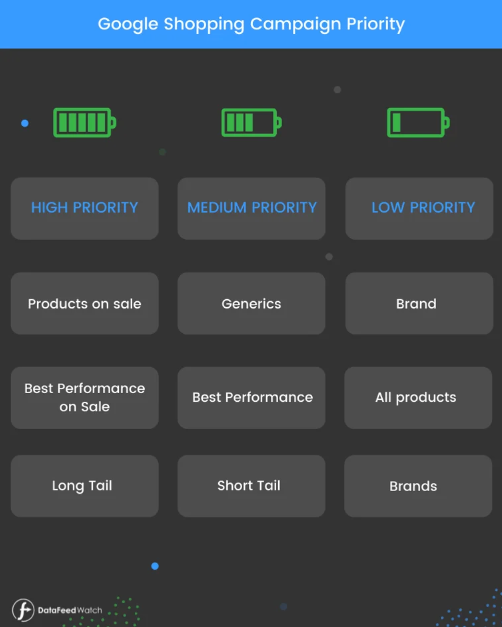
High priority Google Shopping campaign
This is your primary Google Shopping campaign. The ads will be triggered by all relevant search queries except those you add as negative keywords. In this campaign, you can put your products on sale or your best-selling products on sale. You can also include products with long tail keywords in the titles.
The intention behind this approach is to drive sales by leveraging the psychology that people are more inclined to make a purchase when an item is offered at a discounted price compared to its regular price.
Medium priority Google Shopping campaign
In the medium priority campaign, you can include your best performing products that are not on sale and also products with slightly more generic titles.
You can also add products that you've prevented from appearing in a high-priority campaign because you've set negative keywords.
Low priority Google Shopping campaign
This campaign can include all products from your offer without adding any negative keywords. It can also include products with low priority sales.
Tactic 2: Brand-based campaign breakdown
The brand-focused campaign proves beneficial for retailers aiming to enhance their conversion rate by isolating their brand-specific keywords and best-performing keywords.
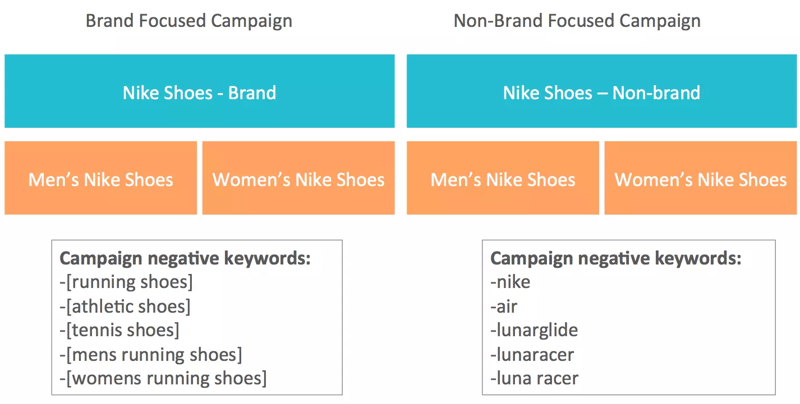
Google Shopping brand-based campaign | SearchEngineJournal
High priority Google Shopping campaign
This campaign is designed to target non-branded terms. You have the option to include negative keywords for your brand/-s. You can also exclude your best-performing keywords - you will put them in another campaign.
Higher bids should be allocated to maximize visibility and generate conversions for these non-branded terms.
Medium priority Google Shopping campaign
This campaign is ideal for branded terms. For example, if your store's name is “Diving Paradise” and you have added this term as a negative keyword, it will be automatically excluded in high-priority campaigns but not in your medium-priority campaign.
It enables you to allocate moderate bids to keywords or products associated with your brand. By setting medium priority, you ensure that these terms are not competing with high-priority campaigns.
Low priority Google Shopping campaign
This priority is used for campaigns targeting specific best-performing keywords or niche products. The keywords targeted in this campaign are added as negative in both high and medium-priority campaigns.
Lower bids should be assigned while maintaining visibility. This type of campaign usually yields high and effective conversion rates.
Tactic 3: Wholesale vs Retail (for B2B companies)
This approach to segmenting Google Shopping keywords is highly effective for B2B enterprises specializing in bulk sales. By catering to the specific needs of wholesale customers, this strategic breakdown elevates shopping ads to a higher level. Implementing a multi-campaign setup amplifies sales outcomes.
High priority Google Shopping campaign
In this campaign, we recommend setting your bid at $0.01. To optimize results, we suggest adding “bulk” and “wholesale” as negative keywords in your Google Shopping campaign.
Low priority Google Shopping campaign
This campaign is designed for the most exceptional and high-performing terms.
Tactic 4: Optimizing product data with generic vs product-specific keywords
This tactic involves optimizing product keywords in your product feeds depending on how broad search queries you want to target.
This will help you showcase the ideal product for the most relevant search query in two possible scenarios: when people are not looking for anything specific and use broad search terms and when people know exactly what they want and use specific search terms.
Two categories of keywords are:
- Generic Keywords
These are broad search terms that encompass a general category or type of product.
- Product-Specific Keywords (Long-tail keywords)
These are more specific keywords that directly relate to a particular product, allowing for more targeted and precise searches.
Generic keywords
When it comes to generic keywords, the likelihood of immediate purchases is lower. Generic searches are usually conducted for research purposes as part of the buyer's shopping journey. But not always.
All you have to do is decide which products should have generic titles and descriptions, since they have a chance to appeal to potential buyers who are not looking for any specific product.
There are two methods you can employ to achieve optimal results from the start:
Showcase Best-Selling Products
Start by featuring your top-selling products, as they have proven popularity and appeal to customers. This method will always work
Highlight Products on Sale
Alternatively, you can prioritize products that are currently on sale. However, it's important to note that promotions are not typically executed across all product categories. To ensure effective segmentation, it is advisable to run promotions within specific product categories.
This strategy works exceptionally well when accompanied by a comprehensive promotional plan.
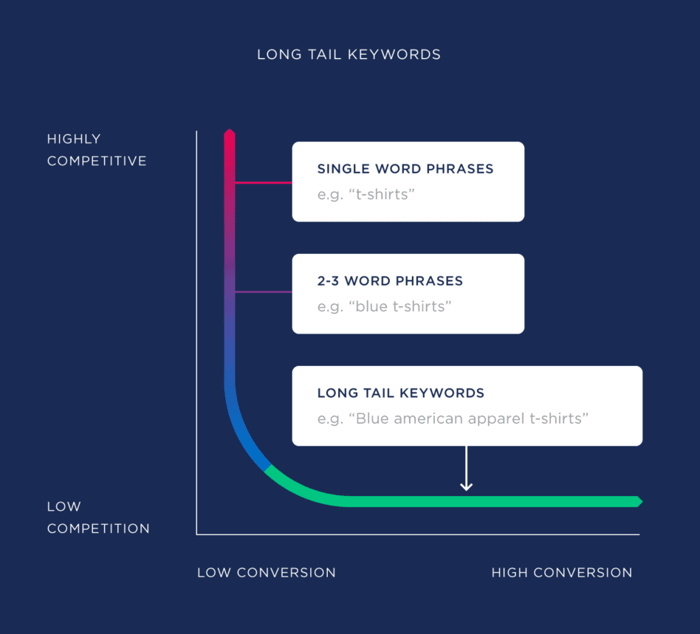
Long-tail keywords in Google Shopping | Backlinko
Product-specific keywords
Sometimes it can be challenging to find the specific Google Shopping ads keywords that accurately represent your products.
Google's search engine usually works well in displaying relevant products. It takes into account the click-through rate (CTR) of each product on a search term and optimizes the representation of search results.
However, relying solely on Google to make this decision may not always be wise, as they may not have enough data to accurately determine the best matching product.
There are certain scenarios where it may fall short:
- Too long long-tail search terms: If the search term is lengthy and the product title doesn't include the exact words being searched, the desired results may not be shown.
- Reversed word order: In some cases, a different meaning can be conveyed if the word order of the keyword is reversed.
If you have a vast product inventory, not promoting the right product with the appropriate keyword can result in significant losses in advertising costs and missed revenue opportunities.
To ensure that the right product is displayed for the proper search term in Google Shopping using product-specific keywords, you can follow these best practices:
Optimize Product Titles
Put the most important keywords at the forefront of your product titles to improve visibility and relevance. This helps Google connect your product with relevant search queries.
Utilize Negative Keywords
Using negative keywords is crucial for targeting the right search terms in Google Shopping campaigns. This helps filter out irrelevant search queries to the products you are selling and improves the performance of your campaigns.
Focus on Keyword-Rich Descriptions
While shopping campaigns don't rely heavily on keywords for determining relevance, incorporating keyword-rich descriptions can help improve visibility and relevance.
Tactic 5: Focus on product titles optimization
When it comes to optimizing your presence on Google Shopping, no strategy is as important as customizing your product titles to target specific keywords.
Surprisingly, most retailers and marketers still do not optimize product titles effectively in Google Shopping. In fact, according to Multichannel Marketing Report 2023, product titles are enhanced by only 11% of all online shops.
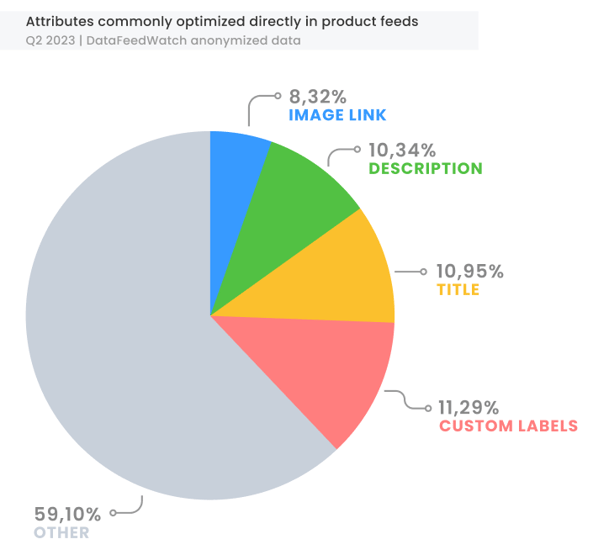
Source: DataFeedWatch Multichannel Marketing Report 2023
By strategically incorporating relevant keywords into your product titles, you can increase the visibility and relevance of your products in search results. Consider including key attributes, such as brand, color, size, and other distinguishing features, in your titles to capture the attention of potential customers searching for those specific details.
The order of the Google product listing ads keywords in a title also matters. Depending on the industry, you can take advantage of recommended title structures that have been created based on years of experience in specific sectors.
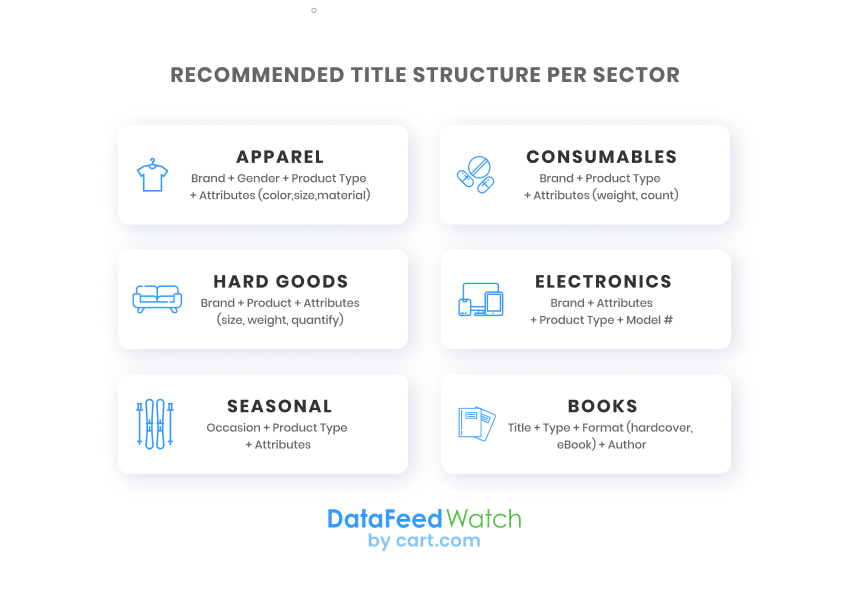
By aligning your titles with commonly searched terms and utilizing keyword research tools, you can ensure that your products are more likely to appear for the right search queries. Taking the time to customize your Google Shopping product titles can greatly enhance your chances of reaching your target audience and driving more qualified traffic to your online store.
Conclusion
Implementing at least a couple of the 5 tactics presented in this article to leverage the best performing keywords for your Google Shopping ads can significantly enhance your online visibility and drive conversions.
By conducting thorough keyword research, optimizing your product titles and descriptions, monitoring performance metrics, utilizing negative keywords, and staying updated with trends, you can stay ahead of the competition and achieve success in your Google Shopping campaigns.
And maybe you can share some other methods on how to optimize keywords in Google Shopping ads? Leave a comment below!
Read more about Google Shopping campaigns:
Ultimate Guide to Google Shopping Ads 2023
How to list your products on the Shopping Tab with Google Search Console?
12 Powerful Custom Labels to Consider for Google Shopping Campaigns

